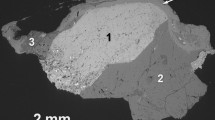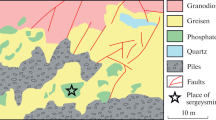Abstract
This paper presents the description of a new eudialyte-group mineral, which was named andrianovite in honor of Valerii Ivanovich Andrianov (1938–1991), a famous Russian mathematician and crystallographer, who developed the AREN software package for structural study of minerals with variable composition. The new mineral has been found in pegmatite from the Koashva open pit, Khibiny Pluton, Kola Peninsula, as rims 0.1–1.0 mm wide surrounding the crystals of typical eudialyte. Aegirine, sodalite, microcline, natrolite, lomonosovite, lamprophyllite, mosandrite, and villiaumite are associated minerals. Andrianovite is light yellow, with vitreous luster and stepped fracture. It is transparent or turbid, with a white streak. The new mineral is brittle; the Mohs hardness is 5. The cleavage is imperfect parallel to (001). The measured density is 2.93(2) g/cm3 (volumetric method); the calculated density is 3.02 g/cm3. Andrianovite is optically uniaxial, negative; ω = 1.622(2), ɛ= 1.617(2). It is nonfluorescent and nonpleochroic. The new mineral slowly breaks down and gelates in 50% HCl and HNO3 at room temperature. It is trigonal, space group R3m. The unit cell dimensions are a = 14.281(4), c = 30.243(7) Å, V = 5342(4) Å3. The strongest reflections in the X-ray powder pattern [d, Å (I, %)(hkl)] are as follows: 2.982(100)(315), 2.860(94)(404), 4.322(71)(205), 3.222(70)(208), 6.447(60)(104), 3.170(50)(217), 5.719(40)(202), 3.540(38)(027). The chemical composition (electron microprobe, H2O and CO2 determined by chemical analysis) is as follows, wt %: 11.61 Na2O, 2.05 K2O, 10.26 CaO, 3.11 SrO, 0.19 BaO, 3.97 MnO, 2.43 FeO, 0.81 La2O3, 1.73 Ce2O3, 0.52 Nd2O3, 0.28 Y2O3, 0.02 Al2O3, 47.06 SiO2, 0.12 TiO2, 11.32 ZrO2, 0.26 HfO2, 2.84 Nb2O5, 0.31 Cl, 0.57 CO2, 0.87 H2O, −O = 0.07 Cl2; total is 100.26. The empirical formula atcat = 53 (Z= 3) is Na12.09(K1.40Sr0.97REE0.60Ba0.04)Σ3.01(Ca5.90Y0.08).98(Mn1.81)Fe 2+1.19 Σ2.90(Zr2.96Hf0.04)Σ3.0(Nb0.69Si0.27Ti0.05Al0.01)Σ1.02(Si25O73)[(O2.14(OH)0.52]Σ2.66[(H2O)1.30(CO3)0.42Cl0.28]Σ2.0. The simplified formula is Na12(K,Sr,Ce)3Ca6(Mn,Fe)3Zr3Nb(Si25O73)(O, H2O,OH)5. The infrared spectrum is given, and the crystal structure is described. The position of andrianovite in the crystallochemical taxonomy of the eudialyte group is shown, and its relationships with other eudialyte-group minerals (kentbrooksite, carbokentbrooksite, georgbarsanovite, etc.) are characterized. The type material of andrianovite has been deposited in the Fersman Mineralogical Museum, Russian Academy of Sciences, Moscow.
Similar content being viewed by others
References
O. A. Ageeva, B. E. Borutsky, N. V. Chukanov, and M. N. Sokolova, “Alluaivite and Genesis of Titanium-Rich Eudialytes from the Khibiny Massif,” Zap. Vseross. Mineral. O-va 131(1), 99–106 (2002).
V. I. Andrianov, “AREN-85-Evolution of RENTGEN System of Crystallographic Programs on Computer of Nord, SM-4, and ES,” Kristallografiya 32(1), 228–231 (1987).
V. G. Feklichev, I. S. Razina, and Z. T. Kataeva, “Types of Eudialyte from the Khibiny Alkaline Pluton,” in Experimental and Methodical Studies of Ore Minerals (Nauka, Moscow, 1965), pp. 188–194 [in Russian].
O. Johnsen, G. Ferraris, R. A. Gault, et al., “The Nomenclature of Eudialyte-Group Minerals,” Can. Mineral. 41, 785–794 (2003a).
O. Johnsen, R. A. Gault, and J. D. Grice, “Ferrokentbrooksite, a New Member of the Eudialyte Group from Mont Saint-Hilaire, Quebec,” Can. Mineral. 41, 55–60 (2003b).
A. P. Khomyakov, Mineralogy of Hyperagpaitic Alkaline Rocks (Nauka, Moscow, 1990) [in Russian].
A. P. Khomyakov, Mineralogy of Hyperagpaitic Alkaline Rocks (Clarendon Press, Oxford, 1995).
A. P. Khomyakov, “Second Chapter in Mineralogy and Crystal Chemistry of Eudialite Group,” in Proceedings of III International Mineralogical Seminar on New Ideas and Concepts in Mineralogy (Syktyvkar, 2002), pp. 107–108 [in Russian].
A. P. Khomyakov, “Crystal Chemical Systematic of the Eudialyte-Group Minerals,” in Proceedings of the 32nd International Geological Congress (Florence, 2004), pp. 309–310.
A. P. Khomyakov, “Crystal Chemical Systematic of the Eudialyte-Group Minerals,” in Proceedings of III International Symposium on Mineral Diversity: Reserach and Preservation (Sofiya, 2005), p. 3.
A. P. Khomyakov, V. D. Dusmatov, and G. I. Ferraris, et al., “Tsirsilite-(Ce) (Na,□)12(Ce,Na)3Ca6Mn3Zr3Nb (Si25O73)(OH)3(CO3) · H2O and Karbokentbruksite (Na,□)12(Na,Ce)3Ca6Mn3Zr3Nb(Si25O73)(OH)3(CO3) · H2O, New Mineral Species of Eudialyte Group from Dara-and-Pioz Alkaline Pluton, Tajikistan,” Zap. Vseross. Mineral. O-va 132(5), 40–51 (2003).
A. A. Konev, E. I. Vorob’ev, and K. A. Lazebnik, Mineralogy of the Murun Alkaline Pluton (Siberian Branch, Russian Acad. Sci., Novosibirsk, 1996) [in Russian].
E. E. Kostyleva-Labuntsova, B. E. Borutsky, M. N. Sokolova, et al., Mineralogy of the Khibiny Pluton (Nauka, Moscow, 1978), Vols. 1, 2 [in Russian].
E. N. Nickel and J. D. Grice, “The IMA Commission on New Minerals and Mineral Names: Procedures and Guidelines on Mineral Nomenclature, 1998,” Can. Mineral. 36(3), 913–927 (1998); Zap. Vseross. Mineral. O-va 128 (2), 51–65 (1999).
O. V. Petersen, O. Johnsen, R. A. Gault, et al., Taseqite, a New Member of the Eudialyte Group from the Ilimaussaq Alkaline Complex, South Greenland, Neues. Jahrb. Miner. Monatsh., 83–96 (2004).
R. K. Rastsvetaeva and V. I. Andrianov, “New Data on Eudialite Crystalline Structure,” Dokl. Akad. Nauk SSSR 293(5), 1122–1126 (1987).
R. K. Rastsvetaeva and A. P. Khomyakov, “Crystal Chemistry of Modular Eudialytes,” Kristallografiya 48(6), S78–S90 (2003).
R. K. Rastsvetaeva, A. P. Khomyakov, V. I. Andrianov, and A. I. Gusev, “Crystal Structure of Alluaivite,” Dokl. Akad. Nauk SSSR 312(6), 1379–1383 (1990).
R. K. Rastsvetaeva, K. A. Rozenberg, and A. P. Khomyakov, “Crystal Structure of the K-Analogue of Kentbrooksite,” Dokl. Akad. Nauk 403(5), 636–639 (2005) [Dokl. Chem. 403 (2), 148–151 (2005)].
M. N. Sokolova, B. E. Borutsky, D. K. Arkhipenko, et al., “On Potassium-Oxonium Eudialyte from Khibiny, Kola Peninula,” Dokl. Akad. Nauk SSSR 318(3), 712–716 (1991).
Author information
Authors and Affiliations
Corresponding author
Additional information
Original Russian Text © A.P. Khomyakov, G.N. Nechelyustov, R.K. Rastsvetaeva, K.A. Rozenberg, 2008, published in Zapiski Rossiiskogo Mineralogicheskogo Obshchestva, 2008, Pt CXXXVII, No. 2, pp. 43–52.
Considered and recommended by the Commission on New Minerals and Mineral Names, Russian Mineralogical Society January 12, 2007. Approved by the Commission on New Minerals and Mineral Names, International Mineralogical Association May 3, 2007. In the previous study on the crystal structure of andrianovite (Rastsvetaeva et al., 2005), this mineral was named a K-analogue of kentbrooksite.
Rights and permissions
About this article
Cite this article
Khomyakov, A.P., Nechelyustov, G.N., Rastsvetaeva, R.K. et al. Andrianovite, Na12(K,Sr,Ce)3Ca6Mn3Zr3Nb(Si25O73)(O, H2O,OH)5, a new potassium-rich mineral species of the eudialyte group from the Khibiny alkaline Pluton, Kola Peninsula, Russia. Geol. Ore Deposits 50, 705–712 (2008). https://doi.org/10.1134/S1075701508080060
Received:
Published:
Issue Date:
DOI: https://doi.org/10.1134/S1075701508080060




